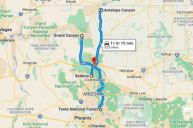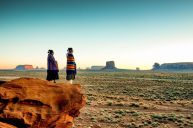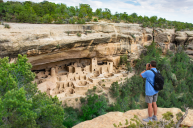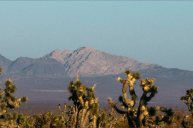The United States recently proclaimed November National Native American Heritage Month — A notion to educate, gain awareness, and give special recognition to the first inhabitants of North America (or "Turtle Island"). More accurately named Indigenous Peoples' Heritage Month, this is a time to honor the cultures, languages, art, and lives of the hundreds of Indigenous communities and tribes that call America home. (Not to be confused with Indigenous Peoples' Day on October 11.)
Consider taking an educational and enriching visit to a state park, national park, or national monument this month. It's a great way to discover the ways of the world and land before settlers and colonization formed the United States of America. Non-Indigenous people must do their part in learning, sharing, and supporting the original occupants of our country.
Hashtags to connect and begin conversation around NAHM include #IndigenousHeritageMonth, #NativeAmericanHeritageMonth, and #FindYourPark or #EncuentraTuParque.
Mesa Verde National Park, Colorado
https://www.instagram.com/p/CVqfrvdPHuo/
In the Four Corners region of the Southwest lies a remarkable piece of Ancestral Pueblo and Ute history. This UNESCO World Heritage Site is situated in modern-day Mancos, Colorado, just outside of Cortez. Mesa Verde National Park boasts unimaginable cliff dwellings that date to approximately 1,500 years ago.
These elaborate communities made of stone and the natural surroundings stand as a testament to the indigenous people's ingenuity, strength, and creativity.
In the late A.D. 1200s, the Pueblo people left their community. There is no written record on what happened or why, but the archeological sites they left behind demonstrate their accumulated skills and advanced civilization. Visit Mesa Verde to celebrate the Indigenous people of this region.
Navajo Nation, Arizona
https://www.instagram.com/p/CVfuOkpJpI3/?utm_source=ig_web_copy_link
Modern-day Arizona is the heart of the Navajo Nation, sacred land with a deep and fascinating history. A guided tour by a personal Navajo guide is the best way to absorb the stories and culture of this fascinating group of warriors.
Some fascinating day trips and attractions in Navajo Nation include Canyon de Chelly National Monument (guide required, except for White House Ruins Trail), Antelope Canyon in northern Arizona, and Monument Valley Navajo Tribal Park near the Utah Border.
Glacier National Park, Montana
https://www.instagram.com/p/CVK4DbVF9mG/
RELATED: Miccosukee Indian Village Festival Is a Can't-Miss for Native Culture
Located in modern-day Montana, Glacier National Park offers evidence of human existence over 10,000 years ago. This outdoor paradise run by the National Park Service is home to multiple Indigenous tribes, including the Blackfeet, Salish, and Kootenai bands, who traveled over the mountainous region searching for buffalo and other game.
Find incredible stories of resistance and power when you visit Glacier, which sadly only has less than 25 living glaciers, opposed to the 150 at the induction of the park in 1910.
Old Las Vegas Mormon Fort State Historic Park, Nevada
https://www.instagram.com/p/COMQVxHsQ84/
Every year at the "birthplace of Las Vegas," people can visit the Old Las Vegas Mormon Fort State Historic Park, which holds the Indigenous People's Market and Festival. Dozens of Native artists, crafters, makers, and creators share their art and keep the cultural traditions alive.
According to Native-Land.ca, modern-day Las Vegas is home to the Nüwüwü (Chemehuevi) and Nuwuvi (Southern Paiute) tribes. If you find your way in Vegas around NAHM, be sure to stop by the Old Las Vegas Mormon Fort State Park to delve into the area's Indigenous roots.
Death Valley National Park, Nevada & California
https://www.instagram.com/p/BmDsFhtF8GI/
Straddling the borders of modern-day California and Nevada, Death Valley National Monument is home to the Timbisha Shoshone tribe. These native peoples held and have a sacred connection with the unapologetic desert ecosystem.
The U.S. Government did not formally recognize the tribe as a sovereign nation until 1983, barring tribe members from any management tasks over their land. In 2000, the Timbisha Shoshone Homeland Act allocated a park back to the original inhabitants and created a dual-management system. Visit this arid but beautiful park to discover the history of the Timbisha Shoshone.
Voyageurs National Park, Minnesota
The first inhabitants of modern-day Voyageurs National Park date back to nearly 10,000 years! As the glacial expanse of Lake Agassiz receded, people began moving, hunting, and gathering around the region. More than 220 pre-contact archeological sites reside within the park's borders that visitors can find on the National Register of Historic Places.
Plan a trip to this famous Minnesota park to learn the fascinating history of Indigenous area tribes, including the Anishinabewaki ??"??"'?"???—?'? and O?héthi ?akówi? peoples. You may even catch a glimpse of the Aurora Borealis.
Badlands National Park, South Dakota
https://www.instagram.com/p/CU5GWMlrbUy/?utm_source=ig_web_button_share_sheet
For over 11,000 years, the modern-day "Badlands" region was first home to the paleo-Indians, the Arikara, and the Great Sioux Nation. The seven prominent bands, including the Oglala Lakota, took over the area and forced the Arikara to present-day North Dakota. Proud warriors, equestrians, and hunters, the Sioux Nation tribes produced exceptional leaders like Sitting Bull, Crazy Horse, Red Cloud, Big Foot, and Spotted Tail.
The incredibly unfortunate Wounded Knee Creek massacre occurred in the area, leaving almost 200 Native Indians dead. Fast forward to 1976. The National Park founded a partnership with the Oglala Sioux Tribe, splitting half of the entrance fees between the two parties. To respect the original stewards of the land and honor the fallen at Wounded Knee, be sure to add this northern-midwest park to your list.
Russell Cave National Monument, Alabama
https://www.instagram.com/p/B56CDHcnP2U/
According to Native-land.ca, the Russell Cave National Monument in Jackson County, Alabama, belongs to the Tsalaguwetiyi (Cherokee, East), Shawandasse Tula (Shawanwaki/Shawnee), and the S'atsoyaha (Yuchi) tribes. This relatively small cave has served as a shelter and hunting camp to almost every group that meandered through the region.
For 12,000 years, from approximately 10,000 BC to 1650 AD, Russell Cave has been considered one of the oldest known rock shelters in the eastern United States. To learn more about the ancient uses of this impressive cave, make an excursion to Russell Cave National Monument.
Share your trip to these sites on our Wide Open Roads Facebook!




